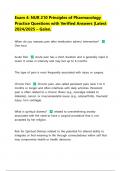Exam 4: NUR 210 Principles of Pharmacology
_’- _’- _’- _’- _’- _’- _’-
Practice Questions with Verified Answers |Latest
_’- _’- _’- _’- _’- _’-
2024/2025 – Galen. _’- _’-
When do you reassess pain after medication admin/ intervention?
_’- _’- _’- _’- _’- _’- _’- _’- _’-_’- _’-
One hour
_’-
Acute Pain _’- Acute pain has a short duration and is generally rapid in
_’-_’- _’- _’- _’- _’- _’- _’- _’- _’- _’- _’- _’- _’-
onset. It varies in intensity and may last up to 6 months.
_’- _’- _’- _’- _’- _’- _’- _’- _’- _’- _’-
This type of pain is most frequently associated with injury or surgery.
_’- _’- _’- _’- _’- _’- _’- _’- _’- _’- _’-
Chronic Pain Chronic pain, also called persistent pain, lasts 3 to 6
_’- _’-_’- _’- _’- _’- _’- _’- _’- _’- _’- _’- _’- _’-
months or longer and often interferes with daily activities. Persistent
_’- _’- _’- _’- _’- _’- _’- _’- _’- _’-
pain is often related to a chronic illness (e.g., neuralgia related to
_’- _’- _’- _’- _’- _’- _’- _’- _’- _’- _’- _’-
diabetes), cancer, or musculoskeletal issues (e.g., osteoarthritis, traumatic
_’- _’- _’- _’- _’- _’- _’- _’-
injury, torn cartilage).
_’- _’-
What is spiritual distress?
_’- _’- related to overwhelming anxiety _’- _’-_’- _’- _’- _’- _’- _’-
associated with the need to have a surgical procedure that is not
_’- _’- _’- _’- _’- _’- _’- _’- _’- _’- _’- _’-
accepted by her religion. _’- _’- _’-
Risk for Spiritual Distress related to the potential for altered ability to
_’- _’- _’- _’- _’- _’- _’- _’- _’- _’- _’- _’-
integrate or find meaning in life through connectedness within self that
_’- _’- _’- _’- _’- _’- _’- _’- _’- _’- _’-
may compromise health or health decisions.
_’- _’- _’- _’- _’-
,What is culture? Culture is a complex and dynamic concept that
_’- _’- _’-_’- _’- _’- _’- _’- _’- _’- _’- _’- _’-
includes the social norms, behaviors, and beliefs of groups of people.
_’- _’- _’- _’- _’- _’- _’- _’- _’- _’- _’-
Culture is dynamic because individuals' attitudes, values, customs, and so
_’- _’- _’- _’- _’- _’- _’- _’- _’- _’-
on change over time as they interact with other groups, expand their
_’- _’- _’- _’- _’- _’- _’- _’- _’- _’- _’- _’-
knowledge, and learn new ways of being. _’- _’- _’- _’- _’- _’-
Characteristics of Culture Cultural beliefs provide identity and a _’- _’- _’-_’- _’- _’- _’- _’- _’- _’- _’-
sense of belonging if they continue to satisfy its members and do not
_’- _’- _’- _’- _’- _’- _’- _’- _’- _’- _’- _’- _’-
conflict with the dominant culture.
_’- _’- _’- _’-
Cultures consist of common beliefs and practices. Most members of a
_’- _’- _’- _’- _’- _’- _’- _’- _’- _’- _’-
culture share the same beliefs, traditions, customs, and practices as long
_’- _’- _’- _’- _’- _’- _’- _’- _’- _’- _’-
as they continue to be adaptive and satisfy the members' needs. Culture
_’- _’- _’- _’- _’- _’- _’- _’- _’- _’- _’- _’-
can influence everything its members think and do.
_’- _’- _’- _’- _’- _’- _’-
Culture is both universal (everyone has it) and dynamic (it changes).
_’- _’- _’- _’- _’- _’- _’- _’- _’- _’- _’-
Cultural customs, beliefs, and practices are not static. They change over
_’- _’- _’- _’- _’- _’- _’- _’- _’- _’- _’-
time and at different rates as members adapt and respond to their
_’- _’- _’- _’- _’- _’- _’- _’- _’- _’- _’- _’-
environment and external influences. _’- _’- _’-
Culture exists at many levels. Culture exists in both the material (art,
_’- _’- _’- _’- _’- _’- _’- _’- _’- _’- _’- _’-
writings, dress, or artifacts) and the nonmaterial (customs, traditions,
_’- _’- _’- _’- _’- _’- _’- _’- _’-
language, beliefs, and practices). _’- _’- _’-
, Cultural values, beliefs, and traditions are passed down from generation
_’- _’- _’- _’- _’- _’- _’- _’- _’- _’-
to generation. Learning occurs through life experiences shared with
_’- _’- _’- _’- _’- _’- _’- _’- _’-
other members of the culture, either formally (e.g., in schools) or
_’- _’- _’- _’- _’- _’- _’- _’- _’- _’- _’-
informally (e.g., in families). Some generations totally adopt the values,
_’- _’- _’- _’- _’- _’- _’- _’- _’- _’-
beliefs, and traditions of their elders, some partially accept them, while
_’- _’- _’- _’- _’- _’- _’- _’- _’- _’- _’-
others reject them. _’- _’-
Cultural assumptions and habits can be unconscious. Thus, they may be
_’- _’- _’- _’- _’- _’- _’- _’- _’- _’- _’-
difficult for members of the culture to explain to others or to identify as
_’- _’- _’- _’- _’- _’- _’- _’- _’- _’- _’- _’- _’- _’-
different from another culture. _’- _’- _’-
Culture is diverse and demonstrates the variety that exists among
_’- _’- _’- _’- _’- _’- _’- _’- _’- _’-
groups and among members of a particular group.
_’- _’- _’- _’- _’- _’- _’-
What is religion?
_’- Religion refers to an ordered system of beliefs
_’- _’-_’- _’- _’- _’- _’- _’- _’- _’- _’- _’-
regarding the cause, nature, and purpose of the universe, especially the
_’- _’- _’- _’- _’- _’- _’- _’- _’- _’- _’-
beliefs related to the worship of a God or gods
_’- _’- _’- _’- _’- _’- _’- _’- _’-
What is a cultural stereotype?
_’- _’- A cultural stereotype is an
_’- _’- _’-_’- _’- _’- _’- _’- _’- _’-
unsubstantiated belief that all people of a certain racial or ethnic group
_’- _’- _’- _’- _’- _’- _’- _’- _’- _’- _’- _’-
are alike in many respects.
_’- _’- _’- _’- _’-
Stereotypes are often, but not always, negative. They are, however,
_’- _’- _’- _’- _’- _’- _’- _’- _’- _’-
assumptions that should not factor into an objective assessment or
_’- _’- _’- _’- _’- _’- _’- _’- _’- _’-
evaluation of any patient. _’- _’- _’-





